Lately, you’ve been dreaming of having your own suckermouth pleco, but don’t really want to look after a 2 feet long monster.
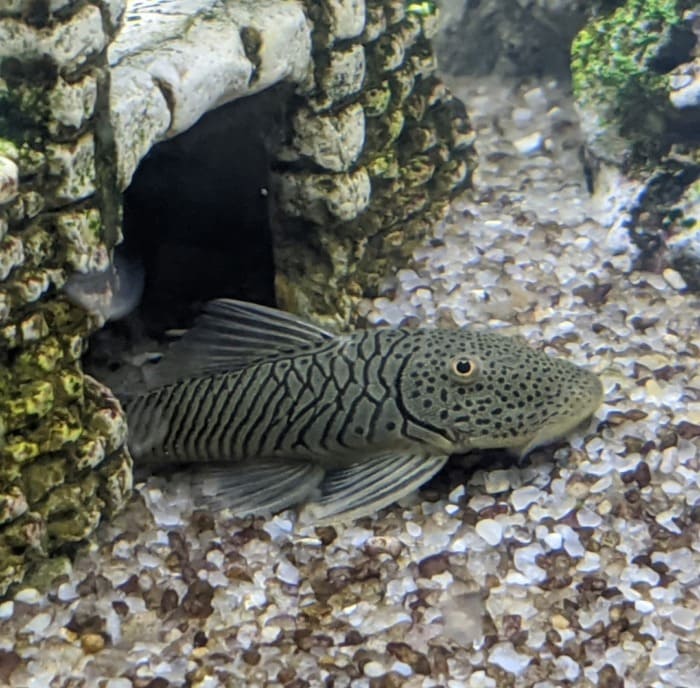
The rubber lipped pleco’s size should come in handy.
To have someone furiously cleaning the tank for you is a luxury, right?
But will the rubber lip plecostomus really snack on algae?
Does this pleco species require extensive care? Are they as aggressive as their larger cousins?
In this Aquanswers guide, you’ll learn everything you need to know about the Rubber Lipped Pleco…
Short Introduction to the Rubber Lipped Pleco

The Rubber lip pleco is a bottom-dwelling, freshwater fish that belongs to the Chaetostoma genus.
Chaetostoma is part of the largest family of catfish – the suckermouth armored catfishes. Besides “Rubber lip pleco”, other common names for this fish are striped Rubber nose pleco, striped or blonde bulldog pleco, Chaetostoma sp. L444.
These fish have specially enlarged gills speculated to serve the purpose of breathing while being attached or feeding.
They are also avid algae consumers (under certain conditions).
Males can be distinguished from females by their broad head, large pelvic fins, and slim abdomen.
The pelvic fins play a role in breeding by keeping the sperm from getting washed away by the strong water current.
A common misconception about Rubber Lip Plecos
Fish stores often confuse the RL with the Rubber pleco (Parancistrus aurantiacus) and falsely advertise them as one another.
The most distinctive differences between the two, in layman’s terms, are the maximum growth size and the coloration.
Rubber Lipped plecos have spots on their head where the Rubber pleco (also known as Chubby pleco) has somewhat crossed stripes.
A true RL pleco will reach no more than 4.5 inches in body length and will not experience a dramatic change of color.
On the opposite side, the rubber plecos reach up to 7 inches, later shifting from grey to gold-ish coloration.
I’ve chosen two photos with a pronounced distinctive coloration so that you could compare them.
Here’s how a rubber lipped pleco (Chaetostoma formosae) looks like:
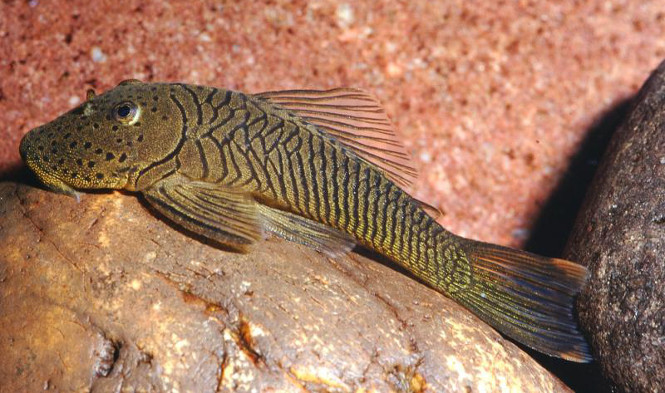
And here’s how a rubber (Chubby) pleco looks:
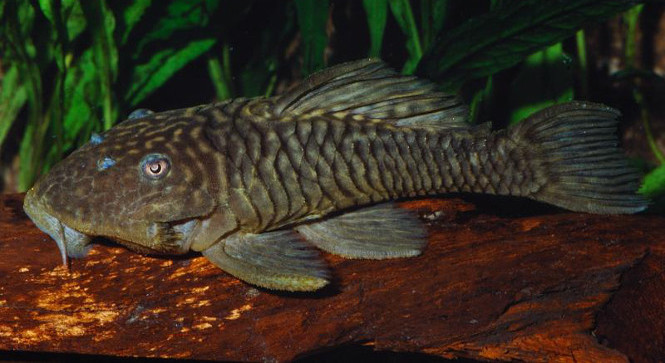
I’ve never had the luck to witness mine become gold, as it appears the fish decides when that will happen and if it will happen.
However, when it comes to differences that’s about it.
Both of these plecos have similar needs in terms of care (except, of course, tank size) hence the common confusion.
If you already bought yours or plan to get one soon you will be satisfied with either.
Don’t worry if you’ve got the Rubber pleco, this guide is for you as well.
They grow really slow. You’ll have your time to prepare a bigger tank later on.
Expected max size of a Rubber Lipped Pleco
This species of pleco remains relatively small compared to its brothers:
A Rubber Lip pleco will reach a maximum size of 4.2 inches (10.6 cm) in full body size. The Chubby Rubber pleco, as established, will grow up to 7 inches (17.7 cm), which is still not near enough a Common pleco.
In small tanks (20 gallons) Chubby plecos should reach about 5 inches at max, before being relocated to a larger one.
Anyway, Rubber Lippled plecos are slow growers, so don’t be bothered if yours does not hit these numbers soon after its arrival.
I’ve had mine add about an inch in one and a half years.
Bear in mind that this does not mean you can stick either species in any tank with less than 20 gallons of volume.
They may not grow much, but they do require their scavenging space.
They can also get territorial among each other, other plecos, or any catfish, for that matter.
If you’d like to enjoy more than one I’d strongly suggest that you provide them with at least 55 gallons of a fish tank for starters.
If it’s a long well-planted one – even better.
Related read: Small Pleco Fish That Grow To No More Than 4.3 Inches
Diet & foods
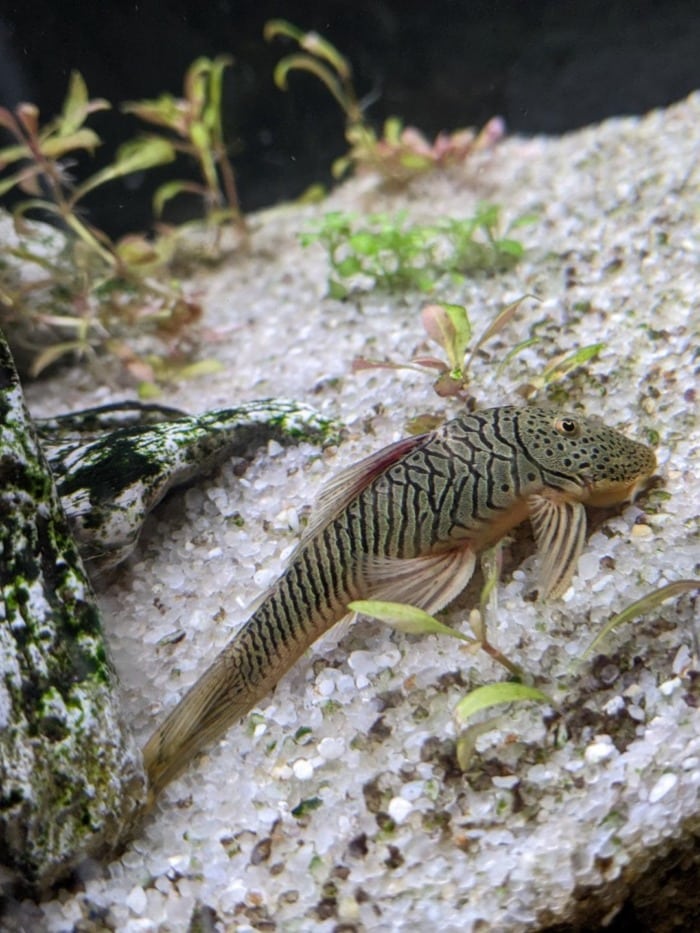
RL plecos eat algae almost exclusively unlike other species of pleco. Though they are classified as omnivores they would much prefer sticking to a herbivorous diet.
However, it is possible for them to lose interest in the natural growth of your aquarium.
Once they get comfortable with externally-supplied foods (meaning you feeding them) that deviate from a mainly algae-based diet they may give up on your aquarium’s algae.
This only happens in extreme cases when they were fed this way from an early age.
With practice, I learned that it is really best if I purchased mine when they were young.
When I’m about to get one I always ask the guys at the store to give them some veggie or algae wafers, just to make sure they will eat it.
Young ones are just under 2 inches.
If you’re hoping that they will keep your algae growth under control you’d need to confirm that they are still interested in that.
I had this one Rubber Lip who would eat anything BUT algae…
I can’t say it was a waste of money, as I really like these creatures, but rather a waste of talent.
A single Rubber lipped pleco can demolish a heavily algae-infested 20-gallon tank in just under two weeks.
Or so I’ve witnessed in my personal experience.
Another reason they may not be interested in cleaning up a tank is not enough CO2 for your plants.
Such conditions favor the algae allowing it to fortify its cell walls.
This makes it harder and therefore unappetizing to fish. Learn more about that in the guide I wrote on exterminating black algae for good.
By the way, Rubber Lip plecos do eat black algae, along with green, blue, and brown algae.
They can definitely be placed among the ultimate algae-destroying machines.
You can learn more about top-performing algae-eating fish (and not only) here, in my guide. That being said you should never count on algae growth alone for your RL pleco’s diet.
Rubber Lip plecos love eating:
- Zucchini (preferably fresh)
- Spinach
- Romaine lettuce
- Spirulina
- Peas
- Cucumber
- Seaweed algae sheets
- Algae Wafers
A rubber lipped pleco’s diet should be almost entirely plant-based.
Here and there you can drop them some meat though, but don’t overdo it.
These fish can eat freeze-dried bloodworms, tubifex worm, or brine shrimp.
High-quality flake food will be alright too.
On some occasions, people report their Rubber Lips would eat carnivore pellets as well.
Just know that the digestive system of the rubber lipped pleco is designed to digest plant matter and fiber.
For more on feeding your aquatic pets check out The Ultimate Guide to Fish Food: Pros and Cons & Best Choices!
Expected lifespan
With good care, the Rubber lip plecos will live up to 12 years.
And fortunately, they’re not difficult to look after.
They’re quite hardy and there aren’t any diseases they’re specifically prone to.
However, stress can still have an impact on their well-being as with every other fish.
Therefore, maintaining pristine water quality and furnishing the tank with enough hiding spots, is essential for the longevity of any rubber lipped pleco.
Additionally, you’ll want to put yours in a friendly environment, avoiding aggressive aquariums.
Author’s note: Rubber lipped plecos don’t have any scales on their body, so you should avoid using salt or copper treatments in case of a disease.
Behavior & compatibility
Rubber Lipped plecos don’t like living with aggressive tank mates.
They are very peaceful by nature.
All they would want to do is lie around or comfortably hide in an artificial cave.
They are a good addition to a community tank.
RL plecos will not really bother your other fish, unless there are other plecos, as they get a tiny bit territorial among each other.
This can be avoided by providing them with plenty of space to roam.
To see some good ideas on calm community fish that will get along with your Rubber Lips, click here. Anyway, they also like to hide under or hang out on smooth-surfaced round rocks that resemble the bottom of a river.
Naturally, they LOVE having some driftwood around.
If you haven’t any, I have a pretty decent guide on where to find such wood. It’s a part of their natural habitat.
My observations are that if they could they would forever glue themselves on it.
Anyway, they will be more active if nothing is stressing them but are an overall shy fish.
Whenever I was watching my Galactic Algae Destroyer, as I named him, he would just stand still and pretend to be a statue.
As soon as I turn my back, however, he’d start moving around and switching hiding places.
These critters are mainly nocturnal and you won’t see them doing much before the lights go off.
After actively spying on them I figured that mine would come out during the night and go about their business.
It’s after dark when they will feed on your algae.

How to take care of a Rubber Lip Pleco?
Rubber Lipped plecos really enjoy heavily planted aquariums, that are well-aerated.
A medium to high water flow is a must as their natural habitats are the rivers in Peru, South America.
They will greatly appreciate smooth stones or wood under a current for their chill spots.
They like to have hiding places, as they are not fond of others’ attention during the daytime.
The minimum tank size for a single Rubber Lip pleco is 20 gallons (the Long tank version is better), but as this hobby goes, it’s always recommended to scale up the minimum requirements if you can.
I’d say a larger tank would make them happier. A 55-gallon tank has a bottom with dimensions of 48.25 x 12.75 inches which can be ideal for this small pleco.
Author’s note: Some online sources argue whether a Rubber Lipped pleco should be kept in 15 or 25-gallon tanks. To someone familiar with aquarium sizes, these arguments are meaningless. That’s because we need to take into account that, for the most part, this pleco species is a bottom dweller.
The bottom footprint of a standard 15-gallon tank is 24.5 x 12.5 inches. The bottom of a standard 25-gallon tank covers 24.25 x 12.5 inches, the same as a standardly shaped 20-gallon Tall tank. As you can see it’s pretty much the same space, in the context of keeping a Rubber Lipped pleco.
Anyway, a fully grown 7-inch specimen of Chubby Rubber pleco should be relocated to a 75 or a 100-gallon tank.
The pH levels of the aquarium water should be in the range of 6.5 to 8 and the KH levels – between 8 and 12. The general hardness of the water should be between 10 and 15 dGH. An ideal temperature for the Rubber Lipped pleco is between 71 and 78°F (21.5 to 25.5°C).
Breeding
Successfully breeding a rubber lip pleco in captive conditions is extremely challenging.
There are very few reports of breeders being able to achieve this, and none of them come from credible sources.
The difficulty in breeding these fish stems from the lack of sufficient water current in home aquariums.
In the wild, the female lays a clutch of eggs underneath a flat surface that’s exposed to a strong water flow.
The male then attaches himself to the surface and protects the eggs until they hatch.
Since this new role is extremely taxing on the male’s body, his energy needs and oxygen consumption get increased.
Hence the need for a strong water current.
Supposedly, setting up a circulation pump blowing water down the length of the aquarium along with a mixture of pebbles and slate should meet these criteria and provide suitable breeding conditions for the rubber lipped pleco. However, I haven’t tried this yet, so it’s up to the more opportunistic among you to give this method a try.
Don’t forget to post a comment if you do.
Where can you buy one?
After some feedback from my readers, I realized that not everyone was so lucky to find a Rubber Lipped pleco in their local fish store.
I managed to negotiate a delivery for mine with a salesman near my location.
However, if you aren’t able to find this type of pleco where you live, you could simply order it online.
One place that I’ve seen Rubber Lip plecos for sale is AquaBid, but there are also other online aquarium stores that you could try. Visit the link and check out the retailers that specialize in selling freshwater live fish to improve your odds of finding one.
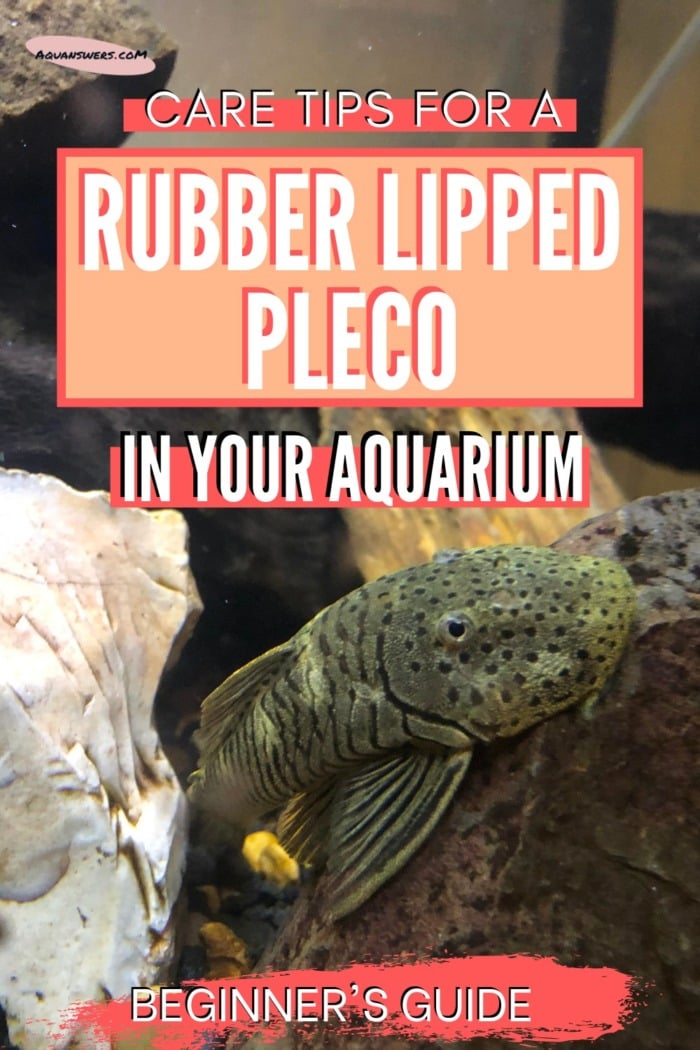

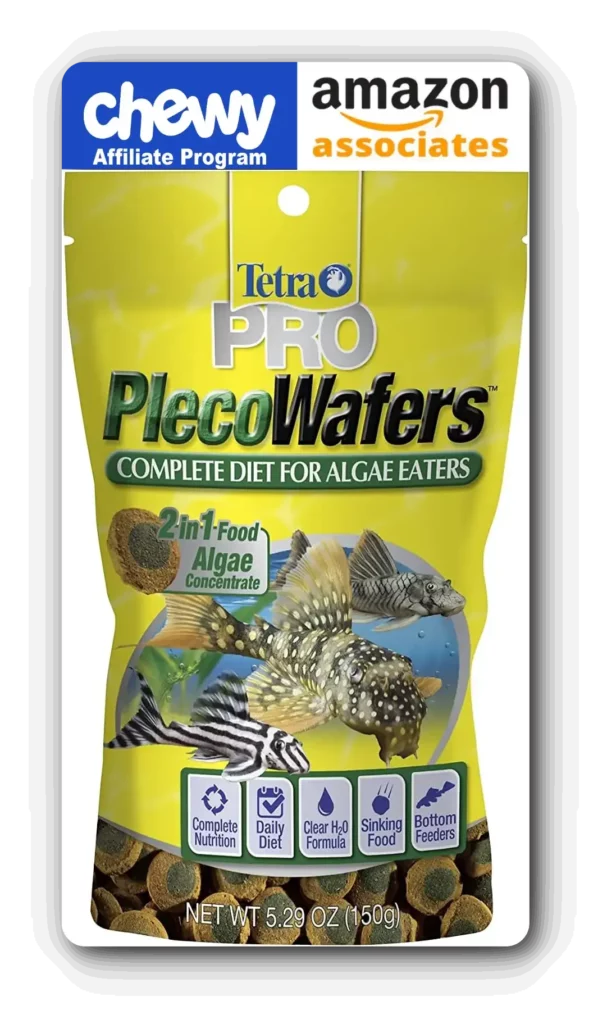

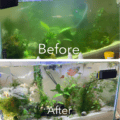
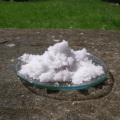
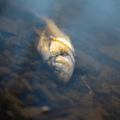


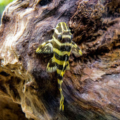
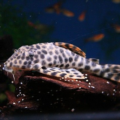
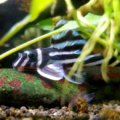
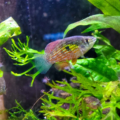
I had a small algae outbreak so i went to my LFS in search of a pleco to tackle the job.
my tanks temperature stays between 76-78°f i asked the person in the LFS which pleco would be a good tank mate and described my other fish and i was sold the rubber lip mostly cause my wife said it was cuter then the other choices.
Ive had him/her for well over 3 months now the algae is gone so i had to go buy algae tablets cause well dont want the lil guy starving to death.
so far ive been pretty lucky i do water changes every 2 weeks but other then that im new to the aquarium hobby so im not up to par with all the ph maintenance etc id probably end up gettong confused with all of it i do have 2 filters and 2 bamboo plants that im supposing help alot as none of my dwarf gourami’s have died ive lost 1-5 guppies out of maybe 20
after reading the article you said the RL are territorial i have noticed my RL attacking one of my dwarfs when it got too close to the bottom mostly just bumping and pushing its not very often i see it do this and no damage done. I was thinking of getting another cleaning fish but after reading i dont know if its alright or not.
Id like to add a shrimp to the tank however i dont want an epic battle of the bottom dwellers on my hands with that said, are RL plecos only territorial to other plecos or all bottom dwellers?
Hey Justin,
That’s a very good question!
They are mostly documented for being territorial towards their species, other plecos or similar looking catfish.
Dwarf gouramis are generally considered peaceful, but on some occasions (you know..personalities…), they may act as semi-aggressive fish. Especially if you have more than 1 male. They may be bothering the pleco.
1. Try dropping something meat-based in there for him (from time to time).
2. Make sure he has hiding places where he could retreat when bothered by others – increase decoration if needed.
3. If you want to add other cleaning fish – head over to my article on algae eaters for ideas. A bottom dweller may not be a good idea (though I’ve seen a RL share a tank with cories with no issues, so there’s that). You can go safe and add top dwelling cleaning fish or shrimp/snails.
4. Consider your tank’s size when adding new fish (do not overstock!).
5. Water parameters are not that complicated. Here’s what you should be looking for => 0 ammonia, 0 nitrite, 15 to 25 nitrate. Get a test kit if you don’t have one and measure.
Helpful?
I have a 50 gallon corner tank with a school of 8 tiger barb(4 green platinum and 4 albino) and 8 barb(4 cherry and 4 gold). Would a RL work with these guys?
Hi,
Depends.
Have you noticed any aggression among them? You did well to keep them in semi-large schools to avoid it.
If everything seems fine so far and there are some cover and hideouts (just in case!), then a RL will work, yes.
Keep me posted : )
Would a rubber lipped pleco do okay in a planted 29gallon tank kept at 78 degrees?
Hi Zai,
Yes, they are slow growers and your guys should be fine for a good amount of time. However, I’d recommend relocating him when the time comes.
The temperature should not go above 78 IMO.
Hope this helps.
Hi,I had just recently purchased a RL Pleco for a tank mate for my 2 goldfish. The 2 goldfish love colder water down to 68 degrees and I was wondering if that temp was too cold or okay for the fish?
Hi, Lacie!
I’d suggest that you make a slight exception and put 2 degrees up? Will your goldfish be too cranky about it?
Hope this helps!
Hello!
I’ve recently purchased a new pleco a few days ago, he’s definitely not the first one I’ve had, and noticed something strange. He’s attaching himself upside-down to my aquatic plant, now reading this article I’d like to state I haven’t introduced him to a female nor even had a female. Is this behavior okay?
A reply would be well appreciated, but if not that’s fine too! 🙂
Note: other than this he’s acted completely normal
Hi Cheyenne,
I haven’t seen mine do that actually.
If he’s doing it near the stream of the filter it may or may NOT be a mating behaviour of some sort.
Other than that I don’t think it’s strange, as far as my observations each pleco has its own personality and there are weirdos among them…
Hope this was of help to you!
Stay well.
I searched for a L444 rubber lip but couldn’t find one, so I went with a Chaetostoma thomasi, L188a. It looks exactly like the fish in the first picture above. I purchased it about a year ago as a tankmate for my fancy goldfish. I think I ordered it from Live Aquaria (online store).They share a 55 gallon tank, planted with anubias & cryptocoryne, which are about the only plants that my goldfish leaves alone. I use a very large canister filter that keeps the water clean (goldfish are dirty) and creates a lot of water flow on one side of the tank, and I have some large driftwood and smooth rocks in the tank. I don’t heat the tank anymore because the light keeps the water around 72-75 degrees. My RL is extremely shy, and I have gone months without seeing him/her. Around the time I think maybe my pleco die, I’ll suddenly catch it hanging on the tank wall! But he/she seems to do a nice job of keeping my tank walls clean.
Thank you for your input, Dana!
I giggled at the part where you say you thought your pleco died because I can relate.
Anyway, for some time now I suspect that Live Aquaria is just wrongly advertising their RL plecos. If yours looks like the one in the photo and hasn’t grown much, then you probably got the right one.
Thank you for your very detailed comment, I’m sure you’ll help someone out.
I can not find anyone that sells the Rubber lip, any suggestions? Desperate
Hi, David,
Where are you from? If you’re situated in the US, you can definitely try online sellers, but that’s a hit and miss approach.
In my opinion, it’s always best to see the pleco for yourself before the purchase, but if you don’t have other options, then perhaps, you should give online delivery a chance.
Sorry if this was of no help to you!
Keep looking!
I am in Los Angeles, I have tried many of the larger aquarium stores and the only place that says they have the Rubber Lip is Pet Smart, and I find that suspect….. L444 is what I should reference yes?
I now have you picture on my phone, and they should always have the scale look not the spotted look, yes?
Thanks
Yes, David, that’s on the head. Exactly as the picture shows. I agree about Pet Smart though. Ask around on fishkeeping forums, perhaps?
I found a supplier, and your article is dead on! I keep thinking that they may have gone on to fish heaven, and then just like that they show up. Thanks for the information, it was a great help.
They are a really great fish and I am trying my best to popularize them!
Glad I converted you! 🙂
I was gifted a RL pleco and sadly enough he didn’t last long before finding him dead in bottom of tank. I want to get another one eventually but worried about it happening again and they aren’t cheap at my LFS. I had to add some aquarium salt to my tank recently because a few fish were looking sick and they seem to be much better now. If the water in my tank has aquarium salt in it, could this harm a RL Pleco being a scaleless fish? Want to make sure my tank is perfect before trying to add a new one.
Hi, Mr. CJS,
Most all scaleless fish are sensitive to salt by definition.
However, my experience shows that rubber lips can tolerate small quantities (usually used as a preventive measure).
In fact, at one point I was also battling itch. I used aquarium salt and my pleco seemed fine throughout the whole treatment.
I know it sounds controversial, but it was my last resort back then, and there was this one friend of mine who told me it would be ok because she was breeding plecos with regular additions of aquarium salt with no problem.
Hope this helps!
Do share your story after you get the little guy.
Also, just a quick note: RL plecos like their water a bit on the colder side, so make sure your tank’s not too warm for it. This is a common mistake I see people making with these guys.
Stay well.
Thanks for the tip! I’m slowly doing some water changes to try and get s much salt out of the aquarium as I can before introducing a new Pleco. I’m actually probably going to add a Chubby Pleco to the tank, not a RL. Would you recommend same thing temp wise though? My current aquarium is a consistent 78 or so and I’ve kept it at that for quite some time. What temp would you recommend?
Thanks for the advice!
Thanks for the advice!!! I appreciate it. I’m hoping to get a Chubby Pleco in a few days! What is the water temp you would recommend? I have my tank at a consistent 78 right now and has been for quite sometime with all my other fish in there. I’m just hoping this time I can keep the lil guy alive for quite some time. I had my water tested at LFS and they said there is absolutely nothin wrong with the water, so I’m hoping to add a new one soon.
Hi CJS,
I didn’t know which comment to approve so approved them both!
Anyway, 78 degrees should be fine for a Chubby pleco, but I’d deem that the upper limit. They can gradually adjust anyway, but I think they’d be somehow more comfortable at 76. I’d say if 78 is what your other fishes like, keep it at that but don’t let it rise.
Hope this helps!
These plecos are lovely and I’m sure you’ll enjoy having 1 or 2.
Stay in touch!
I have a new 45 gal.tank and one 4” gold fish (another story). I don’t have any live plants as I don’t know how to care for them. I have a good canister filter. Will a rubber lipped pleco be a good addition to my tank?
Hi, Pam.
Yes, a rubber lip would be a suitable tank mate for a goldfish because they enjoy similar water temperature and won’t be aggressive towards each other.
You should definitely provide some sort of hideout for the pleco though, as they like to hide and feel less stressed that way.
Some rocks or other artificial decors might come in handy.
About plants… Goldfish like to uproot plants and snack on almost all greens in the aquarium… So there’s that.
Hope this helps, Pam!
Tell me how it all went for you.
I really hope your brand new tank is properly cycled, or you’ll just kill the pleco and waste all your money. Dont add anymore fish until uput tank is cycled. Trust me, I did it the hard way, you dont have to
Do you know where I can buy a rubber lip? None of the pet stores around me sell them. Can i buy them online?
Hi, Tina,
That’s actually a really good question… I was able to negotiate mine with my LFS for a delivery. I made sure to explain exactly how they look because I already knew I could end up with different-sized fish. I strongly suggest that you try that first. I already had some sort of relationship built with my salesman, so I guess that helped with my “order”.
If that doesn’t work, however, then yes, you can order them online, and that’s not hard to do it from a reputable fish retailer.
Hope this helps!
Keep me posted, we may help other people in your situation.